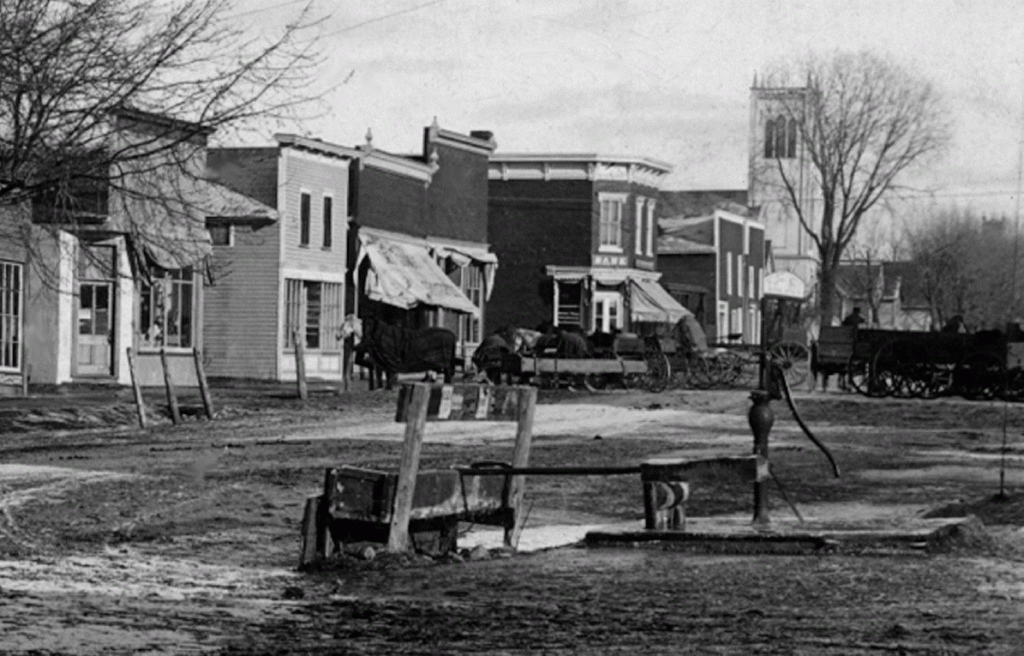
SRHS
Steamboat Rock Historical Society
TIMES ARE CHANGING
THE TOWN IS INCORPORATED
The pioneers of Hardin county were a mixed group of nations, characters, languages, conditions and opinions. There was hardly a State in the existing Union that was not represented among the early settlers. All the various religious sects had their advocates here too.
Among those who arrived between 1851, and 1875 when the town of Steamboat Rock was incorporated, there
were merchants, craftsmen, and farmers.
Incorporation of the town under the general laws of the State of Iowa came in 1875, some twenty years after it was laid out.
At the time of incorporation the mayor was A. W. Wales. R. H. Waite was recorder, and the council members were H. W. Kelly, J. C. Root, Jerome Seabury, Thomas W. Neesen and D. B. Cartwright.
In twenty years many new businesses had been started in the town. Interestingly none of the original with exception of the mill and hotel remained twenty years later. Both of these remained but the Mill had been converted from a sawmill to a grist mill, now owned by S. F. Lathrop who was involved with one of the banks, and the grain and lumber business. The changes did not mean that they were unsuccessful. It only means, that as stated earlier, many businesses were used to raise money and buy land and go into farming. Many of the former business men had done just that.
There were three hotels now one was owned by A. S. Root, who had tried his hand as a farmer and merchant before entering the hotel business 1863. Mr. Root had completely renovated the hotel a year earlier. Another hotel the Western House which began as the Reuben Wright Hotel was now owned by I. M. Silverthorn, who
leased the property to E. M. Campbell at the end of 1875, with Campbell taking possession in May of the following year. A news article indicated that Campbell paid Silverthorn with 600 acres of wild land in O’brian county. The third hotel was on Market Street in a building that remains today as an apartment building. It is not
known when this hotel first opened, but in 1975 it was know as the Green Hotel. The growth in the number of hotels tells us town was growing and many new faces were arriving almost every day.
Mr. M. Ackerman, had opened a hardware store in town and was in the iron pump business, telling us that good wells were being dug in the area He had arrived early on in 1856. Carrier & Ackerman sold farm implements.
H. B. Lawrence had a hardware as well, He came on the scene in 1868, and he featured tin ware and stoves.
H. W. Kelly was in the dry goods business opened in 1868, and carried clothing, hats, caps, boots, crockery and
glassware, all of which were prior to the railroad difficult to come by.
J. E. Snyder opened two years earlier in 1866, and his dry goods and carried clothing, boots, shoes hats and caps.
Two banks were now open in Steamboat Rock, one the Farmers Exchange bank with A. A. Noyes as president, and Cartwright Lathrop & Company Bank.
W. W. Riekena, was in the land business and had served as a collection agent since 1865.
Mrs. R.C. Wright had a Millinery shop, and Miss Evens operated the Emporium of Fashion
Other businesses included A. M. Irins, Harness and Saddlery, established 1865. G. A. Lynk, Restaurant, established 1869. J. W. Tracy, was a druggist, established 1867, and R. C. Wright was also in the drug business Two grain elevators, a lumber yard, and the following farmers, G. Arnold, L,E. Campbell, J. T. Hardin, J. H.
Higginbotham, P. Ireland, G. H. Rockwell, E. Wheeler and B. Wheeler. There were certainly many other farmers not listed here.
In June of ‘75, new walks were added at the cemetery and a general cleanup was undertaken.
In November of 1875, the town council appointed James Young Marshall and street commissioner.
The council also passed an ordinance that all businesses were required to have a sidewalk. It is presumed that most of these early walks were made of wood.

Here we see wooden sidewalks, hitching posts, the town pump and horse watering troth. Horses and wagons on Market Street in Steamboat Rock. All were common sights until the automobile came on the scene the early 1900’s. Even then the hitching post was still a common sight around town until the late 1930’s.
© 2020 Steamboat Rock Historical Society | All Rights Reserved
Powered by Hawth Productions, LLC